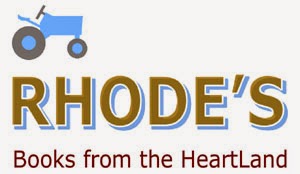To the back
of this rustic print my father, Joseph Rhode, taped a quotation he typed on a
slip of paper and illustrated with colored pencils: “I tell you that the great
cities rest upon these broad and fertile prairies. Burn down your cities and
leave our farms, and your cities will spring up again as if by magic. But
destroy our farms and the grass will grow in the streets of every city in the
country.” The words are those of William Jennings Bryan, a populist who lost
his bids for President of the United States three times. My generation
remembers Bryan as a character in the movie (and play) Inherit the Wind (1960). The quotation that my father chose as a
caption for the rural scene is from Bryan’s famous “Cross of Gold” speech.
 |
| Farm Horses and Wagon in Green Frame |
The print depicts a team of horses pulling a wagon along a road beside a river in spectacular scenery reminiscent of the Blue Ridge Mountains. The young couple in front of the house and stone wall includes the man wearing the straw hat while driving the team and the woman feeding the chickens while drying the laundry. The trees are as fluffy as the clouds of the prismatic day. A lilac bush is in full bloom. The illustration exudes peace, contentment, and love.
My father
“Joe” loved farming with horses, all of them spoiled pets. When he was a boy,
he happily harnessed Togo and Maud on his grandfather’s farm. Later, when he
had a farm of his own, my father proudly drove Queen and Babe. Shire horses
assisted many of his farming tasks until about the time my brother was born. At
that time, he felt that he must modernize by using gasoline tractors
exclusively, and he reluctantly sold his last horses. It must have broken his
heart to do so.
 |
|
Togo, Maud, and Joseph C. Rhode in April 1930
Photo by Mrs. Allen
|
When my father passed away at a ripe old age, I discovered in his desk drawers numerous pamphlets, brochures, and books on horses. Joe grew up with the family tradition of Dan Patch, arguably the first sports celebrity in the U.S. (His mother’s uncle invented a shoe that helped the young sulky horse become a champion and go on to fame and fortune.) I have the impression that my father liked horses even more than he liked dogs, and he always had a loving dog around!
 |
| Queen, Babe, and Joseph C. Rhode in March 1942 |
Whenever I look upon this rustic print, I think of my father and of my upbringing on his farm. It was in the flat lands of Indiana, not the mountains, but the farm held charms that I distinctly remember to this day. Often, I return to the farm in my dreams.



